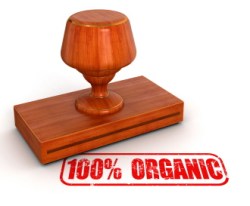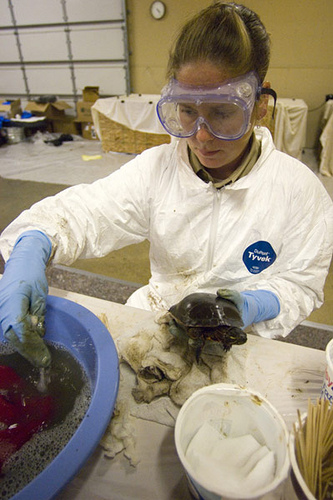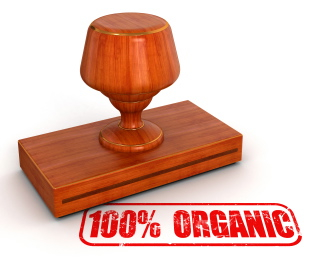 If you’re even remotely interested in food, there’s a very good chance you’ve seen the article that ran in Sunday’s New York Times called “Has ‘Organic’ Been Oversized?” We summarized it here, and it has been all over the web for the last few days.
If you’re even remotely interested in food, there’s a very good chance you’ve seen the article that ran in Sunday’s New York Times called “Has ‘Organic’ Been Oversized?” We summarized it here, and it has been all over the web for the last few days.
Author Stephanie Strom profiled Michael Potter, the owner of Eden Foods, and one of a shrinking list of people who own large, independent companies producing organic food. She also spent a great deal of time detailing the consolidation of the organic industry (a fact many consumers were introduced to by these popular mind map-like charts from Michigan State University). Strom writes:
Bear Naked, Wholesome & Hearty, Kashi: all three and more actually belong to the cereals giant Kellogg. Naked Juice? That would be PepsiCo, of Pepsi and Fritos fame. And behind the pastoral-sounding Walnut Acres, Healthy Valley and Spectrum Organics is none other than Hain Celestial, once affiliated with Heinz, the grand old name in ketchup.
Strom names representatives from companies such as General Mills, Driscoll, Earthbound Farm, and Whole Foods who are currently (or recently) on the National Organic Standards Board (NOSB). And while she acknowledges that only four of the current 15 seats are occupied by people representing corporations, she also points out that all four voted to approve several controversial additives in processed organic foods. (One additive is a synthetic form of the omega-3 fatty acid DHA made from algae oil, which the Cornucopia Institute, an advocacy organization, says is the subject of something they call “Organic Watergate”[PDF].)
It’s chilling stuff, for sure. But is it enough to convince us that — as Strom writes — the organic industry is “mostly pure fantasy”?
On Monday, I was interested to see Strom tweet a response to her article [PDF] from the Organic Trade Association (OTA). After all, OTA does represent those who’d have the most to lose if consumers were to stop trusting the overall organic “brand.”
In its statement, the OTA says the New York Times article “has done a disservice to families seeking healthy choices for their children and farmers choosing organic to stay in business.” They refer to the National Organic Program (NOP) and NOSB as part of “a well thought-out system thoroughly vetted by the industry” — and from what I’ve always heard and observed, I think that’s a commonly held impression of the group. As the OTA sees it, the process behind organic certification and rule making is transparent (open to consumer and industry comments), inclusive, and rigorous, regardless of the scale of the operation. The response reads:
Neither size nor ownership structure matters in organic agriculture. To earn certification, everyone must follow the same regulation and meet the same requirements regardless of size or ownership. The National List of allowed non-organic substances used in organic farming and food process, in fact, is quite limited and well-scrutinized.
… Organic food and farming represent a diverse economic sector fueled by a value-chain with single owner operators, co-ops, mid-sized and larger independent companies, and divisions of the nation’s largest food purveyors. … Currently, there are roughly 14,500 certified organic farms and 2,500 certified organic processing facilities in the United States.
The use of the USDA Organic seal on well-known brands has helped raise consumer awareness of organic. … Our size and growth mean increasingly fewer pesticides applied to soil and waterways, fewer antibiotics given to livestock, a hedge against GMOs, more choices for farmers to stay on the land, and options for families looking for healthy food.
Now, most consumers know that size and ownership structure do often influence the way a company is run. And much of the OTA’s response reads as a bit naïve in today’s world of corporate lobbying. But the association does make some valid points. And as I see it, the organic industry is neither Watergate nor is it a perfectly transparent, well-oiled machine.
And if the New York Times article does little else but raise people’s awareness about the fact that there is a board of individuals constantly discussing what exactly “organic” means, and that the standards they uphold are vulnerable to corporate influence, that’s probably a good thing. But I share OTA’s concern that it could also suggest that all organic food has ultimately been corrupted.
At the base of it, what has always mattered to me about organic is still largely true. Organic farmers are still not allowed to use synthetic nitrogen fertilizer (the cause of the Gulf dead zone and a contributor of a dangerous greenhouse gas), the most dangerous pesticides (although I know people who point to some dangers with organic pesticides, from what I can tell they are much less toxic overall), and they can’t plant genetically engineered seeds. There’s much more to it, but even if the standard stopped there, it would still be a huge, huge step in the right direction.
While mid-sized and large independent organic companies are few and far between, as OTA points out, the number of small organic producers is not unimpressive. (There are all kinds of policy changes, including some that have been up for discussion in this year’s farm bill negotiations, that could help their number continue to grow, but I’ll refrain from getting too wonky here.)
But it’s also worth noting that Strom’s article is mainly about processed foods — the stuff that’s been canned, packaged, frozen, etc., and required additives in the first place. If you’re buying processed foods, it’s always worth reading the label — whether it’s organic or not.
The best thing you can do to ensure that the food you eat aligns with your values is still to buy whole foods directly from the producers you get to know and trust. As I pointed out in my recent post about community-supported fisheries, the more we ask questions, visit producers’ operations, and sign up to support farms, ranchers, and yes, fishermen, directly, the less weight labels begin to carry.
And let’s face it: The fact that there are advocacy groups campaigning to keep DHA and carrageenan (the other organic food additive Strom mentions that has concerned some advocates) out of organic food is also a good thing. In the case of most conventional food, there is no discussion at all, let alone an intensive investigation. It’s all relative; but given the way Big Food has shaped the rest of our food system, organic is still the best we have.
Could organic be a more rigorous standard free of corporate interest? Absolutely. Will I continue to rely on the label to guide some of my food choices? You bet I will.



